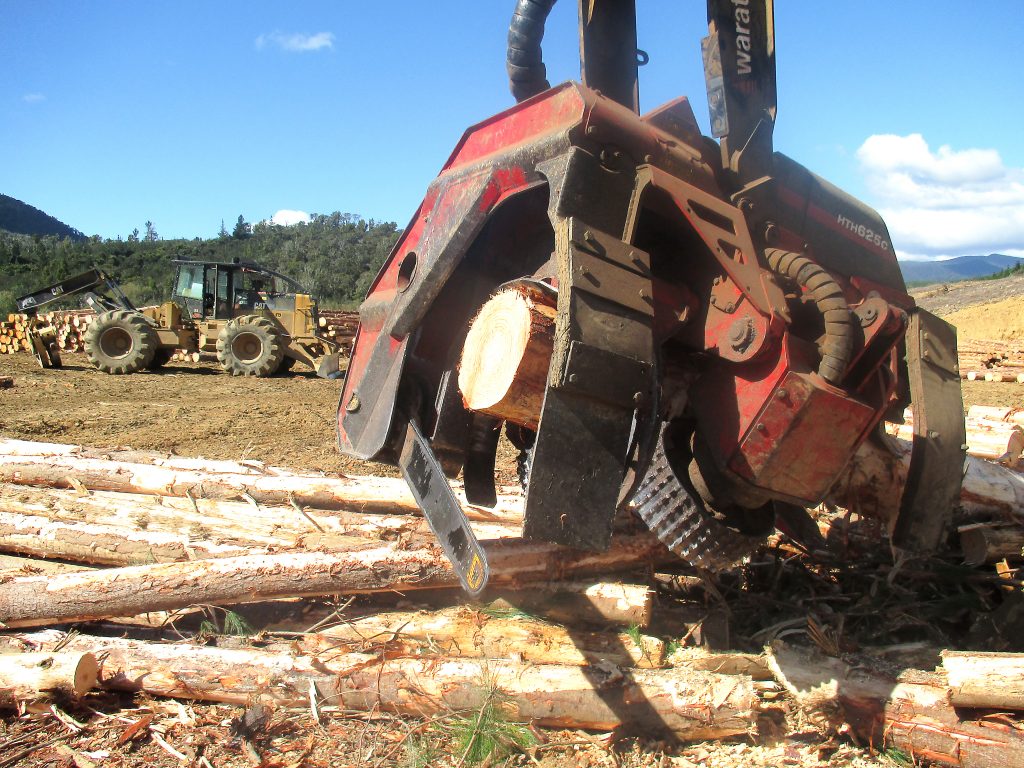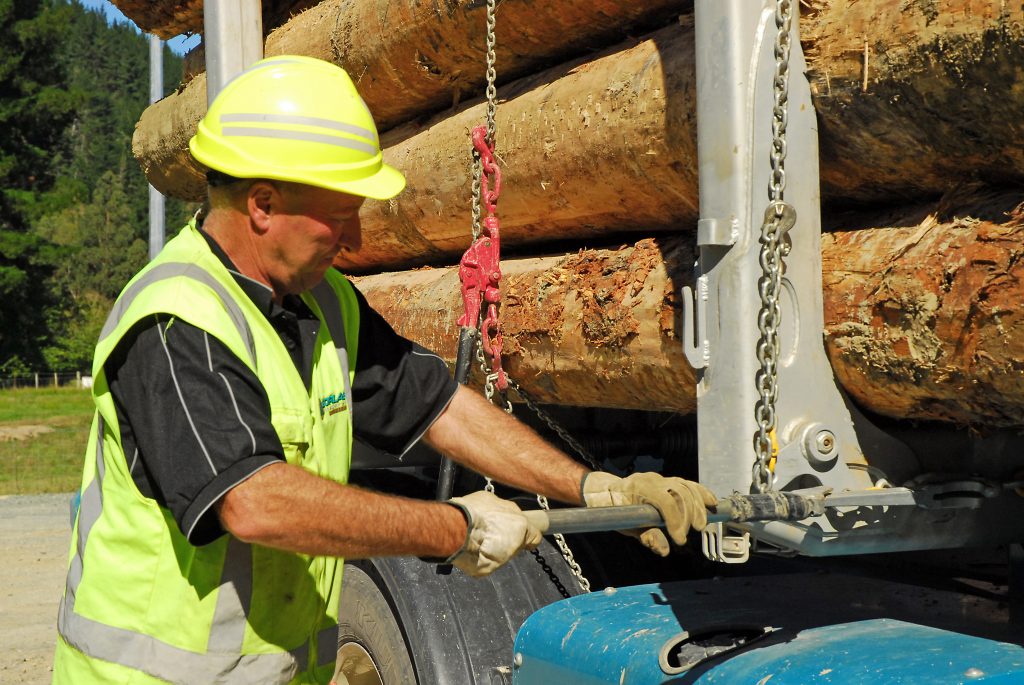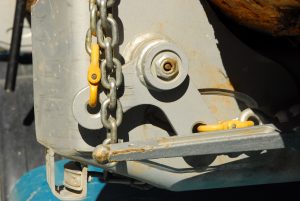
Ingenuity and innovation can pop up in the most unexpected places. Like while you’re sitting in the cab of your Waratah harvester, swinging around its huge, dinosaur-like harvester head with such control and dexterity it’s like a bionic extension of your own arm, giving you the power, in one seemingly fluid movement, to lift a giant fallen tree, strip it of its branches and bark, and precisely cut it into pre-determined log sizes—all in the time it’s taken so far to read this article.
Welcome to Charlie Thomson’s domain, the place where he came up with his novel idea for eliminating chain shot, a very real, very lethal safety risk to any forestry worker in the vicinity of his mechanical harvester.
Charlie, who along with Mike Fraser is part-owner of Nelson Management Ltd’s (NML)* contracting business Thomson and Fraser Processors, explains, “The two mechanised chainsaws working within the Waratah harvester head operate at tremendous speeds under enormous pressure. No matter how good an operator is, they can never stop a chain from breaking, and when it does any small debris that gets flung out is chain shot. Basically, in that moment, it’s flying shrapnel.”
Ten percent of all chain breaks will feature chain shot, and while the Waratah operator is protected by the cab they sit in, safe behind its 17mm bullet-proof glass, any other workers on the skid site, or other machinery or vehicles, are potential targets.
Charlie’s solution at first seems beguilingly simple: devise hanging guard flaps to block the chain shot from escaping beyond the harvester head.
But as he discovered, the guard flaps needed to be flexible enough to not constrict the ability of the unit to drop close to the ground for trees to be scooped up, yet not so flexible that they routinely got in the way of the chainsaws and damaged them, or became damaged by the saws themselves.
“And they had to be tough enough that if they do get struck by the saw blades, they wouldn’t be wrecked and of no further use. After all, it’s a lot easier and cheaper to sharpen chainsaw blades than replace a $500 flap.”
The final design has ended up being a mix of nine layers of laminated rubber and specially located reinforcing steel plating, precisely positioned to cover any angle of trajectory the chain shot might take.
“The rubber absorbs the impact and deflects the chain shot downwards to the ground. There are four guard flaps in all, two shielding either side of the main saw blade, and two shielding the topping saw blade. That’s the really critical one with the widest chain shot range—it can basically turning the entire skid site into a target.”
It’s taken Charlie a full 18 months of design variations and field trialing to devise a proven prototype that meets the high safety standards he’s been after. So convinced is NZ-based manufacturer Waratah of the value and future of Charlie’s breakthrough, it is building and due to open soon a specialised facility in Tokoroa devoted to developing his concept even further.
“Waratah want to keep me involved for ongoing design assistance and testing,” says Charlie. Given Charlie’s 30-years experience in forestry, the past 20 operating Waratah harvesters, that’s hardly surprising. In fact, it was thanks to Charlie, and in particular his business partner Mike Fraser, that the first Waratah was brought to work in NML’s forest estate back in 2002. “Mike was a huge believer in the technology—he was determined to mechanise the top of the South,” says Charlie.
NML are thrilled with Charlie’s latest innovation. “Safety is everything to them, but they also appreciate how the elimination of chain shot risk increases the ability for the company’s mechanical harvesters to be used in more constricted areas where skid sites are smaller.”
At a cost of around $800,000 per harvester, the log producing behemoths represent a huge investment—making the $2000 for a set of four chain shot guards a small price to pay to make the units much safer and even more capable in the field.
It’s a good news story all round—and all thanks to the sharp thinking of one clever man in a harvester cab.


New Log Truck Safety Innovation
In a world first, NML is implementing a new approach to scheduling harvesting crews that is being watched with a great deal of interest by other forestry companies, both locally and globally.
NML’s Resources Forester Marion Hughes and Business Performance Analyst Nigel Brabyn are currently rolling out a supply chain software system called CrewSO (Crew Scheduling Optimisation) that allocates, tracks and manages supply and demand in NML’s 78,000 hectares of forest in the Nelson and Marlborough regions.
“CrewSO is a system that integrates forestry management software, supplied by Trimble Forestry, and a resource modeling tool, developed by Remsoft, (both Canadian-based companies), that enables us to get the right products, from the right harvesting crews, to the right customers, at the right time,” says Nigel.
By focusing on customers’ order and delivery needs first, NML were able to work back and design a system that revolutionises the manual and arduous spreadsheet system previously used for scheduling logging crew operations. “CrewSO optimises the harvest plan,” says Marion. “It uses the customer’s orders and matches it with available resources to come up with the best value for the customer and the business. It works out which harvesting crew should harvest each area and which customer that wood should be delivered to. This is a world-first, crew-scheduling tool that creates an optimised solution using the most up-to-date data available. It can solve this complex problem in only a few minutes!”
Many forestry companies, including NML, have designed supply and demand models over the years but they were stand-alone, one-off models that could only solve one question at a time. Often by the time they had the answer, the question that needed to be answered had changed. “What’s new about CrewSO is that we have integrated it with our day-to-day management systems so it can be run using near real-time data supplied directly by a wide range of operational and sales and marketing staff,” says Nigel.
The resulting daily schedule of activity is utilised by a wide cross-section of NML staff to help them manage harvesting operations. Every day the actual results are compared with the company’s harvest plan so that performance can be measured promptly and efficiently.
“The data that CrewSO uses is maintained by the people that are responsible for that part of the business. This creates a sense of ownership of the data and helps keep the quality of the information at a high standard,” says Marion.
“Running CrewSO for our crew scheduling and customer delivery plan is already reducing our operational costs, and it will reduce stress levels for staff and create a more certain workflow for our harvesting contractors. Our product predictions are now more accurate and our customers can be confident that we will deliver the volume of wood they have ordered, and that we will continue to deliver the quality and quantity of wood they require.”
The implementation of the CrewSO system also has the potential to have an ongoing positive effect in the communities in which NML operates such as harvesting equipment being shifted less often between sites, more efficient use of logging trucks, and safer workplaces for harvesting crews.

*[Nelson Management Ltd is the management company for Nelson Forests’ 78,000 hectares of forest in the Nelson, Tasman, and Marlborough regions. More than 600 people are employed across the Nelson business, and the company harvest 1.1 million m3 of timber sales annually. 70% of the logs harvested are processed by local sawmills into products for the domestic and export market]
